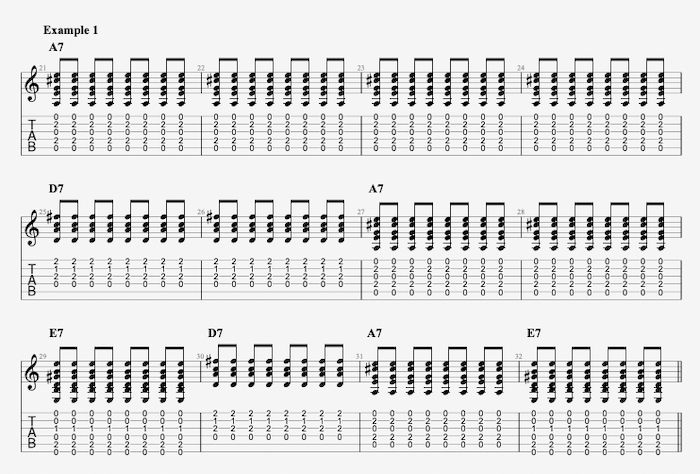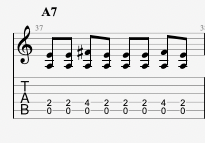3 Simple Ways To Play The 12 Bar Blues Progression
If you want to play any popular American music from the past 150 years… then you’re going to want to be familiar with the blues.
When you do this makes learning your favorite songs so much EASIER.
You’ll start to identify the fundamental patterns beneath the surface of the music. And you won’t feel like you have to start back at square one, every time you go to learn a new song. In this post, I want to share with you 3 simple ways to play the 12 bar blues progression.
These examples are going to be in the key of A major. However, the blues can be played in any key – major or minor. So let’s start with the…
12 Bar Blues Progression Chords
There are 3 main chords to a simple blues progression. These are called the I, IV, and V chords. The I, IV, and V chords are the most common chords in Western music and are essential for understanding harmony. They come from the major scale of a given key and are built on the 1st, 4th, and 5th notes (or degrees) of that scale.
In the key of A major, these chords would be A, D, and E. However, in the blues these chords are often played as dominant seventh chords. A dominant seventh chord is written with just a 7 after the letter name. Let’s take a look at a few ways the 12 bar blues progression chords can be played on the fretboard:
A7 can be played from the 5th string down like so:

D7 can be played from the 4th string down like this:

Finally, E7 can be played using all 6 strings like this:

If you’ve struggled to play blues guitar like Jimi Hendrix, Eric Clapton, B.B. King and countless other old-school masters. Get your hands on my free blues guitar chords cheat sheet. Discover 12 epic blues guitar chords every guitarist should know completely for FREE right here:
Now you may be wondering…
What is the standard 12 bar blues progression?
The standard 12 bar blues progression is one of the most foundational and widely used chord progressions in blues, jazz, rock, and almost every genre. It follows a 12 measure (bar) structure and typically uses the I, IV, and V chords of a key.
The I, IV, and V chords in the key of A major are:
I = A
IV = D
V = E
The most basic 12 bar blues progression is:
I chord = (4 bars)
IV = (2 bars)
I = (2 bars)
V = (2 bars)
I = (2 bars)
All together it looks like:
I I I I
IV IV I I
V V I I
A classic example of this is Chuck Berry’s “Johnny B. Goode”, or Johnny Cash’s “Folsom Prison Blues”.
From there, this can evolve into adding a few more chords:
I chord = (4 bars)
IV = (2 bars)
I = (2 bars)
V = (1 bar)
IV = (1 bar)
I = (1 bars)
V = (1 bar)
All together this new variation looks like this:
I I I I
IV IV I I
V IV I V
Start by playing whole note strums. Count out loud 1, 2, 3, 4, and tap your foot. You want to make sure you spend the proper amount on each chord. If a player gets off with the counting, it’s not going to sound right.

Now that you know the basic idea, try adding an 8th-note shuffle strumming pattern in this 12 bar blues example 1 below.
An 8th-note shuffle strumming pattern is a rhythm used in the blues all the time. The term "shuffle" refers to a specific feel where the 8th notes are played in a "long-short" pattern, giving it a swing or triplet feel.
Let me explain…
In standard 8th-note rhythm, you'd count: 1 & 2 & 3 & 4 &
For a shuffle feel, the &s are played shorter. This means you play the first 8th note (on the count) a little longer than the second one (on the "&"). This creates the swing.
For now, play these using a Down (long) – Up (short) alternating strumming pattern
D (long) – U (short) – D (long) – U (short) – D (long) – U (short) – D (long) – U (short)
This pattern repeats with each set of 4 beats.

There are an (almost) infinite amount of ways to play play the 12 bar blues progression on guitar. Once you get the basic strumming down, try adding some picking and play a riff through the 12 bar blues progression like this:

A great example of a song that uses this type of blues pattern is “Hound Dog” as recorded by Elvis Presley:
The above riff and “Hound Dog” use the blues scale. If you don’t know how to play the blues scale anywhere on the neck grab my free blues scale PDF guide that shows you how in 5 easy steps here:
Finally, for this 3rd variation to the 12 bar blues progression, let’s add a blues rhythm pattern. Blues rhythm patterns are great for spicing up your strumming, and countless famous musicians have used them in hit songs. The basic idea is a root-fifth to a root-sixth movement. For the A chord, the notes would be A and E to A and F# like this:

This can then be applied to the IV chord (D7) like so:

Finally, applied to the V chord (E7) it would look like this:

Putting this all together into the 12 bar blues progression would look like this:

*****
There you have it – 3 simple ways to play the 12 bar blues progression.
Keep practicing, and if you’ve struggled to play blues guitar like Jimi Hendrix, Eric Clapton, B.B. King and countless other old-school masters. Then get your hands on my free blues guitar chords cheat sheet. You’ll discover 12 epic blues guitar chords every guitarist should know completely for FREE right here:
Jon MacLennan
Like this blog post? Get Jon’s best guitar lessons straight to your inbox.
